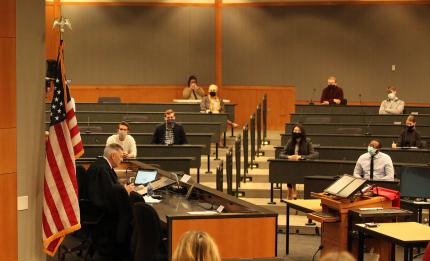Law Students Experience Supreme Court Oral Arguments
Chief Justice Mike Heavican sat alone at the front of the University of Nebraska College of Law’s Hamann Auditorium with Associate Justices projected on a screen behind his chair. Fellow justices were participating in arguments from home or offices, and attorneys argued remotely. As is traditional with online arguments, Court and attorney introductions were repeated before each argument and publically live-streamed on Nebraska Educational Television, then preserved in the Court’s archive.
Following arguments, the Court hosted a private question and answer session for those students who observed from the auditorium and others who joined online.
For over 30 years, the Court has held arguments at each of Nebraska’s law schools, followed by a student question and answer session. Student questions centered on judicial decision-making, verbal presentation of arguments, and Nebraska’s appeals process.
One student commented that 10 minutes for an argument seemed somewhat short, to which justices responded that select case categories are given longer timeslots, including capital punishment cases and constitutional questions. All justices agreed that a 10-minute time limit encourages an individual to focus on the heart of the case.
Justice William Cassel noted when he graduated from law school; the time allocation was 30 minutes, which caused attorneys to become repetitive. Justice Lindsey Miller-Lerman recounted her first argument at the 8th Circuit Federal Court of Appeals, saying arguments were 40 minutes per side which, from her perspective as an attorney, was “way too much time.”
During their 10-minute timeslot, students were instructed to prepare for the weakness of their case, more so than the strength. Justice Papik told students to take for granted that the Court has read the briefs saying, “When you use your 10 minutes, you can jump right into what you think are the important parts of the argument.”
Another student asked if online arguments had changed the Court’s way of doing business, including allowing additional time for arguments.
The Chief Justice noted that all courts are grappling with Zoom and WebEx arguments, particularly in the instances where a cat walks across the screen or children appear in oral arguments. He remarked that Zoom and WebEx circumstances add “another layer” in terms of preparation.
According to Justice Stephanie Stacy, virtual arguments make it harder for her to read her fellow justices, so there are more interruptions and moments of hesitation throughout the process. She added, “I will be thrilled to be back in person for arguments.”
Photos courtesy of Bambi King, UNL College of Law

